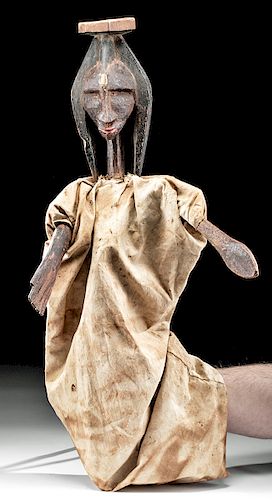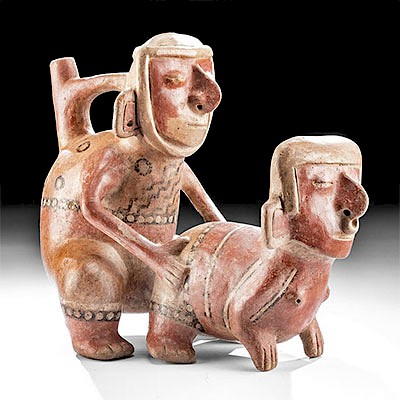Early 20th C. Mali Bamara Wooden Puppet - ex Museum
Lot 70
About Seller
Artemis Fine Arts
686 S Taylor Ave, Ste 106
Louisville, CO 80027
United States
Selling antiquities, ancient and ethnographic art online since 1993, Artemis Gallery specializes in Classical Antiquities (Egyptian, Greek, Roman, Near Eastern), Asian, Pre-Columbian, African / Tribal / Oceanographic art. Our extensive inventory includes pottery, stone, metal, wood, glass and textil...Read more
Categories
Estimate:
$1,000 - $1,500
Absentee vs Live bid
Two ways to bid:
- Leave a max absentee bid and the platform will bid on your behalf up to your maximum bid during the live auction.
- Bid live during the auction and your bids will be submitted real-time to the auctioneer.
Bid Increments
| Price | Bid Increment |
|---|---|
| $0 | $25 |
| $300 | $50 |
| $1,000 | $100 |
| $2,000 | $250 |
| $5,000 | $500 |
| $10,000 | $1,000 |
| $20,000 | $2,500 |
| $50,000 | $5,000 |
| $100,000 | $10,000 |
| $200,000 | $20,000 |
About Auction
By Artemis Fine Arts
Jan 30, 2020
Set Reminder
2020-01-30 10:00:00
2020-01-30 10:00:00
America/New_York
Bidsquare
Bidsquare : Pre-Columbian | Tribal | Ethnographic
https://www.bidsquare.com/auctions/artemis-gallery/pre-columbian-tribal-ethnographic-4830
Featuring ancient and ethnographic art from around the world, including Pre-Columbian, Native American, African / Tribal, Oceanic, Ethnographic, Spanish Colonial, Fossils, Fine Art, much more. Artemis Fine Arts info@artemisgallery.com
Featuring ancient and ethnographic art from around the world, including Pre-Columbian, Native American, African / Tribal, Oceanic, Ethnographic, Spanish Colonial, Fossils, Fine Art, much more. Artemis Fine Arts info@artemisgallery.com
- Lot Description
Africa, Mali, Bamana / Bambara, ca. 1905. A hand-carved wooden puppet with a pronounced head presenting skillfully delineated facial features, a coiffure segmented into incised lobes, a disk-shaped headdress, and a cotton garment. The arms (one with a paddle-shaped hand, the other with delineated fingers) are separately carved and may be moved via long poles hidden beneath garment. The Bambara puppetry tradition is the oldest of Africa's surviving puppetry traditions. Size: 21" W x 32" H (53.3 cm x 81.3 cm)
The puppets traditionally have been used for ceremonies and rituals to ask the gods for rains and resulting crops. According to legend, bush country spirits who kidnapped fisherman created such Malinese puppets, and while kidnapped by the spirits, these fisherman learned the art of puppetry. Upon returning home, they then taught their community how to create puppetry.
Provenance: ex-private Frank and Theresa Caplan collection, purchased in 1983 from Munyoki Musyoka in Princeton, New Jersey; donated to Children's Museum of Indianapolis in 1985 (85.1.15407)
All items legal to buy/sell under U.S. Statute covering cultural patrimony Code 2600, CHAPTER 14, and are guaranteed to be as described or your money back.
A Certificate of Authenticity will accompany all winning bids.
We ship worldwide and handle all shipping in-house for your convenience.
#152187A few tears to the back of the garment. Brown coloring of the garment is likely a natural dye. Wooden elements show minor surface wear with scuffs and a few old chips. Nice pigment on the face (red lips, white decoration on forehead, and black eyes) remains. Minor losses to tips of rods used to move arms of puppet, but these still work nicely.Condition
- Shipping Info
-
All shipping is handled in-house for your convenience. Your invoice from Artemis Gallery will include shipping calculation instructions. If in doubt, please inquire BEFORE bidding for estimated shipping costs for individual items.
-
- Buyer's Premium



 EUR
EUR CAD
CAD AUD
AUD GBP
GBP MXN
MXN HKD
HKD CNY
CNY MYR
MYR SEK
SEK SGD
SGD CHF
CHF THB
THB















